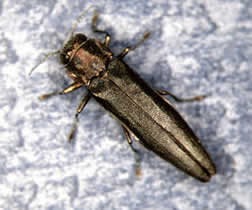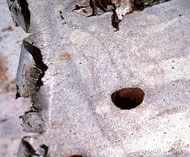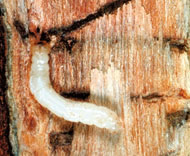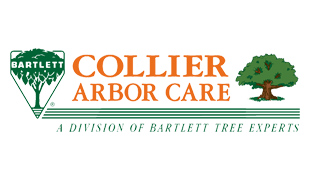|

Adult Bronze Birch Borer Bronze Birch BorerDownload a PDF of this articleDescriptionAdults are small beetles with a bronze body. The larvae stage is the most damaging. The larvae are white with a light brown head. Plants AffectedAll birch species can be attacked but the two most susceptible, the European birch and the white-barked Himalayan birch, are the most widely planted in our area. Symptoms/DamageThe first symptom of a bronze birch borer problem is often yellow, sparse, stunted leaves in the upper portions of the tree which may progress to twig and branch dieback if larval populations are high. A sure sign of bronze birch borer damage is raised bark welts or ridges on the bark, caused by larvae tunneling beneath the bark. Repeated attacks by the larvae eventually disrupt nutrient transport and can lead to tree death. Also when the adult emerges, it leaves a distinctive D-shaped exit-hole about 1/5” wide in the bark. These D-shaped exit holes may be stained with rust colored sap. Life CycleAdults emerge from previously infested trees between early May and early June. They then feed on the leaves of the birch, eventually laying eggs in bark crevices and cracks. Larvae hatch from the eggs and immediately begin to mine into the bark. The larvae damage trees by feeding on the inner bark and over wintering within the galleries. In spring the larvae pupate into adults within the galleries, thus completing the life cycle. ManagementManagement strategies that improve tree health will reduce susceptibility to the borer. Proper cultural practices include watering during dry, hot periods; mulching; avoiding wounds or injury to the tree; and pruning out dead and dying branches. Trees are unlikely to recover once 50% or more of the crown is damaged. Severely infested trees should be promptly removed and destroyed to reduce local borer populations. Systemic insecticide drenches around the base of stressed or lightly affected trees can prevent or help control outbreaks. Borer populations can also be reduced by applying insecticides to the bark to kill larvae before they enter the tree. |

Exit holes made by the adult Bronze Birch Borer 
Bronze Birch Borer Larvae |
|
Home |
Services |
The Arbor Advisor |
Garden Calendar |
About Us |
Fact Sheets |
Contact Us |
Site Map Collier Arbor Care Portland 503-722-7267 Vancouver (360) 693-6056 Site contents and design ©2013 Collier Arbor Care |





